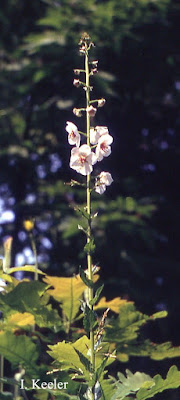 |
| Sacred lotus, Nelumbo nucifera |
But it is the subject of ongoing scientific study because of the longevity of its seeds.
Seeds germinate into new plants. Since plants are immobile, one of the benefits of seeds is movement; the new plant comes up somewhere else.
 |
| Lotus fruits |
 |
| moth mullein, Verbascum blatteria |
Robert Krulwich of Radiolab compiled and related famous dormancy stories: link (Read this article!)
One plant with long dormancy that Krulwich missed is the sacred lotus.

A lake in Pulantien in northern China was used to grow lotus by the Chinese living in that area for generations. But an earthquake drained the lake and the spot was abandoned.
Beginning about 1920, biologists have studied aspects of that former lake and collected buried lotus seeds whenever they encountered them. Pictures of lotus seeds: link
In the 1990s Dr. Jane Shen-Miller of UCLA tried to germinate old seeds from the lake. First she tried seven seeds. Four germinated! The oldest was directly carbon dated and found to be about 1,288 years old, another 684 years. To age a seedling, she had to kill it. Another, later dated 332 years old, grew for a year. But a lab at UCLA is not lotus' natural habitat and the little plant died. It probably would have lived longer in a nasty mucky pond in China.
In 1996 Shen-Miller received about 100 lotus seeds, collected for her by farmers who lived around the former lake. Of those lotus seeds, 80%, aged 450-500 years, germinated.
Lotus grows out of mud. It lives in lakes and pods that intermittently dry out. Substantial dormancy is a survival trait for weathering those dry periods.
Yet a seed is a live organism, taking in oxygen, giving off carbon dioxide. It may do it at a very very slow rate because it is dormant, but it has to do it. The scientific interest in this, since it clearly wasn't a fluke that old buried seeds were still alive, is to understand why lotus seeds can live so long. For most plants, a group of 100 seeds is 99% dead in 10, or at most 30, years.
Shen-Miller and colleagues want to know how the seeds survive and what genes are responsible. They have sequenced most of the lotus genome and are comparing it to other plants, looking at what genes turn on during dormancy and germination, to find the lotus genes that let it endure without dying.
There are important ongoing arguments about when aging is an internal process (tissues wear out), when it is externally driven (mutations, say from natural radioactivity or pollutants, break down tissues), and why repair mechanisms eventually fail. Since clearly lotus seeds don't age the way most seeds do, they offer the potential of important insights into aging. Perhaps the genes that let them survive so long may help with human or other organisms' medical conditions.
 |
| Lotus pond in early spring (with moorhen) |
Long-lived seeds are a wonder, but also a source of important biological information.
Comments and corrections welcome.
References
Ming, R., R. VanBuren, Y. Liu and others 2013. Genome of the long-living sacred lotus (Nelumbo nucifera Gaertn.) Geomone Biology 14:R41. link
Shen-Miller, J. Sacred-lotus, the long-liing fruits of China Antique. Seed Science Review. 12; 131-143. link
Shen-Miller, J., M. B. Mudgett, J. W. Schopf, S. Clarke and R. Berger. 1995.Exceptional Seed Longevity and Robust Growth: Ancient Sacred Lotus from China American Journal of Botany 82(11):1367-1380 summary: link
the article itself link Additional commentary: link
Telewshi, F. W. and J. A.D. Zeevaart. 2002. The 120-yr period for Dr. Beal's seed viability experiment. American Journal of Botany. 89:1285-1288. link
Kathy Keeler, A Wandering Botanist
More at awanderingbotanist.com
Join me on Facebook: https://www.facebook.com/AWanderingBotanist

No comments:
Post a Comment